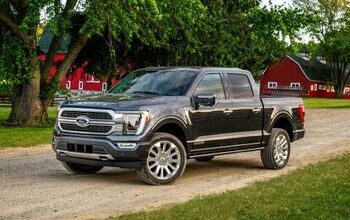Pricing for Base 2021 Ford F-150, Hybrid Revealed

Thanks to a reveal schedule compressed by the pandemic lockdown, the revamped Ford F-150 didn’t soak up a typical amount of limelight before a more exciting new vehicle came along. Luckily for Ford, that model also wore a Blue Oval badge.
By far the brand’s most important product the F-150 enters 2021 with a raft of changes, though the most significant addition is the model’s optional PowerBoost hybrid drivetrain. A first in the pickup world, the package delivers a potent punch with a side of efficiency. Ahead of the model’s arrival in showrooms, the latest F-150’s pricing secrets are starting to be revealed.
Thanks to dealer order guides seen by CarsDirect, we can report that the base 2021 F-150 carries an MSRP of $30,635 after destination, which amounts to a year-over-year increase of $195. That’s for the Regular Cab 4×2 with base 3.3-liter V6, of course. Not exactly every family’s go-to hauler.
Based on what the publication said, it looks like Ford’s not trying to rock the boat with its new pricing ladder. That’s Mazda’s job. The volume XLT SuperCrew stickers for $290 more than the 2020 model, with 4×4 capability adding another $3,495. More comprehensive pricing will have to wait, but it seems the loftiest trims will see a more significant (but not unexpected) price jump.
When it comes to the optional PowerBoost, you needn’t wait for specifics. The hybrid, which pairs a 3.5-liter EcoBoost V6 with a 47-horsepower electric motor integrated into the 10-speed automatic transmission, is said to deliver class-leading power while offering up to 700 miles of driving range. It’s also a $4,495 option, CarsDirect claims.
Available even on the base XL (which that price figure applies to, as well as any other 3.3L model), the PowerBoost option is $500 cheaper than the 3.0-liter Power Stroke diesel V6 offered on XLT trims and above. In addition to its extra muscle, Ford sees low-end retail and fleet buyers gravitating towards the hybrid for its 2.4- or 7.2-kW Pro Power Onboard generators — useful kit when you need a mobile power source at the job site.
If the F-150 you’re looking at carries a standard 2.7-liter EcoBoost V6, moving up to the PowerBoost is a $3,300 ask. Going hybrid reportedly tacks on an extra $2,500 if the truck carries a 5.0-liter V8 or 3.5-liter EcoBoost.
The 2021 F-150 arrives on dealers lots this fall.
[Images: Ford]

More by Steph Willems
Latest Car Reviews
Read moreLatest Product Reviews
Read moreRecent Comments
- Bd2 In the case of a company like Stellanis and their reputation, perhaps they would have better luck with External Combustion.
- Honda1 Only a brain dead moron would do this!
- Master Baiter Ditch the Giga-casting and Robo-taxi. I'd rather have a turn signal stalk.
- Tassos https://carsandbids.com/auctions/rEVNxQ6a/2017-lexus-gs-fA 2017 F version with plenty of HP and less than 100 k miles sold for less than $40k worthless 2024 Idiot Joe Biden $ recently.
- Wolfwagen Of all the vehicle modifications this is one of the stupidest. It is right up there with lifted trucks and rubberbands for tires




































Comments
Join the conversation
..."hybrid drivetrain. A first in the pickup world"... It's not a first in the pickup world. The GM 2-mode hybrid was being built into pickup trucks a decade ago. It was even covered in TTAC. The GM 2ML70 transmission is more complicated than the Toyota HSD, but it basically drives like a big Prius.
So did Ford learn their lesson with the Explorer and MKExplorer? Offering less at a substantially higher price is not the best way to go about things. Or they kept the price relatively close to the last generation (well this IS the last generation with a new grille and headlights) but decontented behind the scenes and we will see the issues start popping up 6 months after they go on sale.